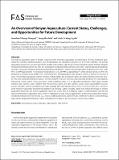| dc.description.abstract | The Kenyan aquaculture sector is broadly categorized into freshwater aquaculture and mariculture. Whereas freshwater aquaculture has recorded significant progress over the last decade, the mariculture sector has yet to be fully exploited. The Kenyan
aquaculture industry has seen slow growth for decades until recently, when the government-funded Economic Stimulus Program
increased fish farming nationwide. Thus far, the program has facilitated the alleviation of poverty, spurred regional development,
and led to increased commercial thinking among Kenyan fish farmers. Indeed, national aquaculture production grew from 1,000
MT/y in 2000 (equivalent to 1% of national fish production) to 12,000 MT/y, representing 7% of the national harvest, in 2010. The
production is projected to hit 20,000 MT/y, representing 10% of total production and valued at USD 22.5 million over the next 5
years. The dominant aquaculture systems in Kenya include earthen and lined ponds, dams, and tanks distributed across the country. The most commonly farmed fish species are Nile tilapia Oreochromis niloticus, which accounts for about 75% of production,
followed by African catfish Clarias gariepinus, which contributes about 21% of aquaculture production. Other species include
common carp Cyprinus carpio, rainbow trout Oncorhynchus mykiss, koi carp Cyprinus carpio carpio, and goldfish Carassius
auratus. Recently, Kenyan researchers have begun culturing native fish species such as Labeo victorianus and Labeo cylindricus
at the National Aquaculture Research Development and Training Centre in Sagana. Apart from limited knowledge of modern
aquaculture technology, the Kenyan aquaculture sector still suffers from an inadequate supply of certified quality seed fish and
feed, incomprehensive aquaculture policy, and low funding for research. Glaring opportunities in the Kenyan aquaculture industry
include the production of live fish food, e.g., Artemia, daphnia and rotifers, marine fish and shellfish larviculture; seaweed farming;
cage culture; integrated fish farming; culture of indigenous fish species; and investment in the fish feed industry. | en_US |

